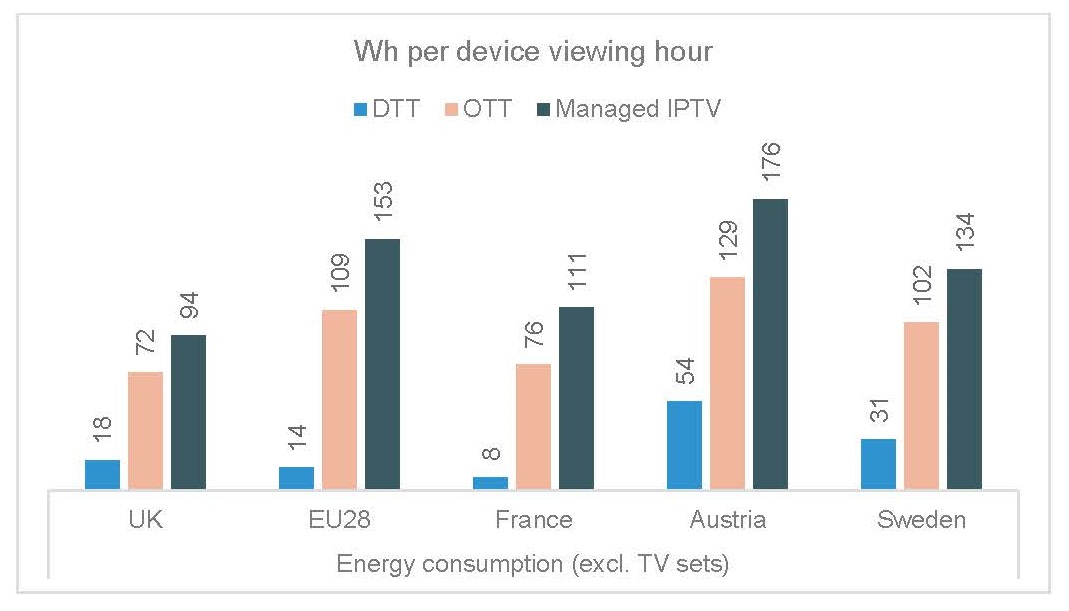
TL;DR
- The carbon footprint of the delivery of TV content has been under-researched to date. A European-based report provides a new benchmark and finds terrestrial delivery less wasteful of CO2 emissions than TV delivered over IP.
- Distribution of Digital Terrestrial Television signals is currently more efficient and less energy-consuming than IP-delivered content.
- Although there is acknowledged uncertainty in the findings, the results — including the lower energy consumption associated with DTT — is aligned with analysis conducted by other orgs including the BBC.
READ MORE: Quantitative study of the GHG emissions of delivering TV content (LoCaT Project)
Good, old over-the-air broadcast TV is greener than streaming, finds new research drawing on data from across Europe.
The LoCaT Project’s report, “Quantitative study of the GHG emissions of delivering TV content,” concludes that energy consumption and associated emissions of Digital Terrestrial Television (DTT) are “an order of magnitude lower” than estimates for OTT and managed IPTV.
This is true today — and in the future, the report states.
Its findings chime with that of a recent InterDigital and Futuresource report, which found that the carbon footprint of the video entertainment industry has ballooned to exceed even that of the airline industry. The report also aligns with recent studies by the Carbon Trust and the BBC.
READ MORE: New white paper examines the innovative solutions ushering the video entertainment industry towards a more sustainable future (Interdigital)
READ MORE: The carbon impact of streaming: an update on BBC TV’s energy footprint (BBC)
The LoCaT report focused just on TV delivery, not content creation, and aimed to compare the greenhouse gas (GHG) emissions associated with serving TV content across different platforms.
It analyzed all 27 EU countries plus the UK in 2020, and estimated that the energy consumption associated with one device viewing hour of DTT was 14Wh compared to 109Wh for OTT and 153Wh for managed IPTV. This equated to 3 grams of CO2 equivalent emissions (CO2e) for DTT, 26 grams CO2e for OTT, and 37 grams CO2e for IPTV.
This only considered viewing hours on TV sets, and excluded the energy consumption of the television itself. Excluding TV sets — assumed to be the same for each delivery method — enhanced the comparisons.
The pattern was found to be the case across all countries, but the reduction in emissions is most pronounced in countries with higher DTT penetration. Additionally, differences between countries relate to national energy infrastructure For example, overall emissions were lower in France and Sweden than EU28 averages due to electricity grids in these countries being less dependent on fossil fuels.
The LoCaT report explains that DTT viewership consumption is more energy efficient due to its simplicity. “DTT efficiency is due to most DTT households using a passive aerial connection to access the network, usually with a direct connection to TV sets without the need for peripherals. This is in contrast to managed IPTV that requires using a share of the in-home modem-router and — currently across European markets — a set-top box to decode content and offer additional features such as OTT apps.”
The authors stress that there is “inherent uncertainty” in their modeling noting that this is especially the case for in-home peripheral, as well as network modeling, where there is limited data at the country level.
Data from ISPs on the energy consumption of their networks, as well as the implications of increased demands on their network, would be a valuable contribution to the analysis, the report suggests.
It is also expected that video streaming organizations and broadcasters will have a detailed knowledge of their own audience, including their viewing time and choice of devices. This may impact on the estimates of energy consumption per viewing hour and could provide more accurate figures than the country-level average estimates produced here.
Consequently, the LoCaT Project calls for a common methodology to allow companies to benchmark against each other, and to provide a streamlined way to report these estimates to their stakeholders.
Primary data was drawn from LoCaT Project sponsors including Broadcast Networks Europe (BNE) — the trade organization of DTT network operators in Europe, French content delivery technology provider Quadrille, and French streaming platform Salto.
The report, compiled and written by management consultancy Carnstone, also used market research published by organizations such as European Audiovisual Observatory, BARB, Ofcom, and the European Broadcasting Union to understand TV viewing behavior across Europe.
SUSTAINABILITY ACROSS M&E — BUILDING FOR NOW AND THE FUTURE:
Media & Entertainment has a big environmental impact — think carbon emissions, waste and energy use. The video entertainment industry’s carbon footprint has surpassed even that of the airline industry, prompting technology developers and other companies to step up with innovative approaches and practices. Explore handpicked articles from NAB Amplify to discover why sustainability is the number one priority for M&E, along with the latest trends in creating a greener future:
- Nominations Are Open for the NAB Show Excellence in Sustainability Awards
- Can AI Reduce Carbon Emissions?
- Yes, Video Is Terrible For the Planet… But We Can Change That
- How to Grow Sustainability in Media and Entertainment
- Why Live Production Has to Up Its Sustainability Game





